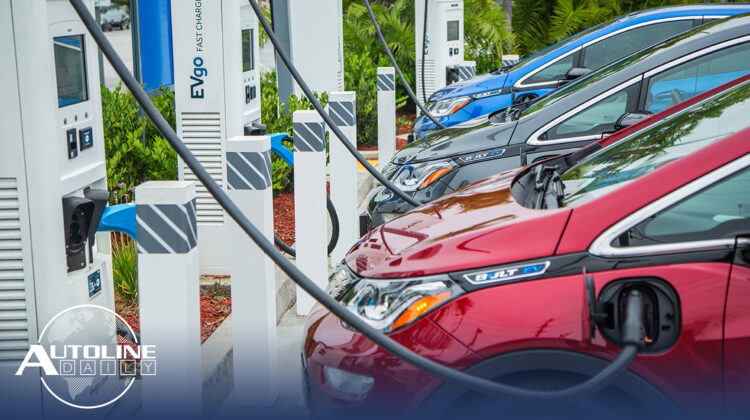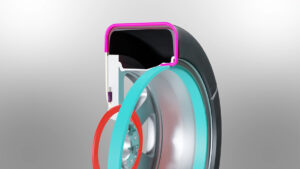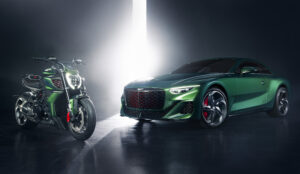
Follow us on social media:
Runtime: 10:59
0:00 Free EV Charging Hogs the Chargers
1:24 Our Next Energy Demotes CEO
2:47 New York Coming Close to Congestion Charges
4:05 Tesla Autopilot vs. California DMV
4:50 Some Cybertrucks Qualify For $7,500 Subsidy
5:44 Only Bolt EUV Will Be Back
6:35 Bosch Cutting ICE Jobs
7:11 China Offers $72 Billion In EV Subsidies
8:16 Hyundai’s Mind Blowing Tire Chains
9:33 Ducati To Make Motorcycles for Bentley
Visit our sponsors to thank them for their support of Autoline Daily: Bridgestone and Intrepid Control Systems.
This is Autoline Daily, the show dedicated to enthusiasts of the global automotive industry.
FREE EV CHARGING HOGS THE CHARGERS
Many automakers offer free charging as a perk for buying an EV. And a new study from the Department of Energy, found that owners are taking advantage of it. If it’s free, owners spend 78 minutes charging their EV. If they have to pay, they only spend 42 minutes on average. If it’s free, EV owners use 40.7-kWh of energy, if they pay they get an average of 22-kWh. The ones who charge for free are probably charging their batteries much closer to 100% than the ones who are paying. And as you know, charging to 100% goes a lot slower. You may remember we had charging expert Tom Moloughny on Autoline After Hours begging automakers not to offer free charging because it encouraged owners to hog the chargers. By the way, all these figures we cited are based on 2.3 million charging sessions over the last three years. But it doesn’t include Tesla’s Supercharger network and Tesla says that its owners only spend about 27.5 minutes charging their vehicles.
OUR NEXT ENERGY DEMOTES CEO
Battery startup Our Next Energy or ONE, kind of out of nowhere, abruptly replaced its CEO yesterday. It announced that Paul Humphries, who has been with the company since it was founded in 2020, will take over the leading role. The guy who actually founded the company and was acting CEO, Mujeeb Ijaz, will now serve as the vice-chairman of the board and chief technology officer. It’s not unusual for startups to move their tech-savvy founder into a CTO role and appoint a business-savvy CEO. But it’s got to sting. Mujeeb ijaz said “Change is necessary for growth, and we believe this is our opportunity and the time for growth.” But ONE is facing some setbacks. A UK fund canceled a $100 million investment because of a difference of opinion on the company’s viability. That resulted in the startup laying off 25% of its workforce last month. ONE is also responding to lower demand for EVs and will only make test cells at its new battery factory in Michigan until it has a solid order from a customer. And until that happens, Automotive News reports it will buy battery cells from BYD to use in its products.
NEW YORK COMING CLOSE TO CONGESTION CHARGES
Anyone who’s driven in major cities knows how bad the traffic can be. The average trip across Manhattan averages just about 8 miles an hour. So in June the city wants to implement a congestion charge on any vehicle driving into the lower part of the borough. Passenger vehicles will be hit with a $15-dollar charge, trucks with $24-36 depending on their size, and even motorcyclists will have to pay $7.50. And that doesn’t include bridge or tunnel charges which can add another $13 to $17 to a trip. The whole idea is to make it so expensive that traffic drops off dramatically. Needless to say, motorists, and truck and taxi drivers are dead set against it. That happened in other cities that added congestion charges, like London, Singapore and Stockholm. But that opposition died down when traffic dropped off significantly. However, despite the initial drop-off traffic in London has crept back up. It’s now 5% higher than pre-Covid levels. And it shows that congestion charges alone are not enough to free up traffic in major cities.
TESLA AUTOPILOT VS CALIFORNIA DMV
Last year, the California Department of Motor Vehicles accused Tesla of falsely advertising its Autopilot and Full-Self Driving features for overstating how well the systems work. But Tesla says, hang on a minute. It points out that Autopilot has been around for a decade and the DMV never said anything about it. In fact, Tesla says the DMV implicitly approved the name because it did not take any action or tell the company it couldn’t use the name. Even so, the DMV could suspend Tesla’s license to sell vehicles in California and it could force the company to make restitution to owners. And if it does, no doubt this one will be going to court.
SOME CYBERTRUCKS QUALIFY FOR $7,500 SUBSIDY
In other Tesla news, the U.S. Department of Energy officially approved the Cybertruck for the full $7,500 federal tax credit. But it’s only available for models that don’t cost over $80,000. And we’re quite certain that the truck qualifies for the credit because its battery is made in the U.S.
ONLY BOLT EUV WILL BE BACK
At first, GM was going to scrap the Chevy Bolt EV at the end of this year. But after a number of complaints from owners and EV advocates, GM changed its mind. Besides, the Bolt is the best-selling EV in the US outside of Tesla, so why walk away from that? CEO Mary Barra declared that not only would the Bolt would return in 2025, it would come back with an Ultium battery. And now we’ve got more details. Only the larger Bolt EUV will return. Bigger vehicles sell better in the U.S. and we think the EUVs longer wheelbase makes it easier to package the Ultium battery pack. It’s also possible not much else will change since that will allow GM to use almost all the existing tooling, which will help keep the price down.
BOSCH CUTTING ICE JOBS
Slowly but surely, we’re starting to see legacy suppliers adjusting to the transition to electric vehicles. Bosch announced it will cut 1,500 jobs at two plants in Germany by 2025. Even though it’s difficult to reduce headcount in Germany, Bosch is reacting to the current market. One of those plants makes EGC pumps and components, the other makes Engine Control Units, or ECUs. It’s likely that Bosch decided to eliminate those jobs based on a drop in future orders coming from car companies.
CHINA OFFERS $72 BILLION IN EV SUBSIDIES
Part of China’s master plan to develop its EV sector was to offer generous subsidies to consumers and car companies in the beginning, but then slowly wean them off government handouts until the market was self-sustaining. This year, the government had a change of mind. With overall economic growth slowing, China will maintain consumer subsidies for most EVs. But they have to meet certain specs. EVs have to have a range of at least 125 miles, while PHEVs must offer an electric range of at least 37 miles. And they can’t lose more than 35% of their range in cold weather. The government is committing $72 billion to this program. And keep in mind this does not include subsidies that major cities provide for EVs. For example, people who buy an EV don’t have to pay for a license plate in Shanghai, which can cost over $14,000 at the current exchange rate.
HYUNDAI’S MIND BLOWING TIRE CHAINS
Anybody that has ever driven with chains on their tires or just snow tires knows that you really don’t need them all the time. Unless you live in an area of constant deep freeze, it would really be best to change them out for a regular set of tires during those warmer days that get sprinkled throughout the winter months. But that would be highly inconvenient, so most people just leave them on. However, the Hyundai Group is developing a new product that would change that. It’s using shape memory alloy built right into the wheel and tire package, so you could deploy snow chains at the push of a button. You might be asking yourself, what are shape memory alloys? Basically, they’re metals that react to electricity. During normal driving the shape memory alloy does not contact the road at all by sitting in groves built into the tire, but when a current is applied it returns to its original shape, which causes it to stick above the tire tread. So, when all of them are deployed together, they act like little flaps to help gain more traction. Hyundai says it has patents pending on the technology and is considering launching it on future models.
DUCATI TO MAKE MOTORCYCLES FOR BENTLEY
A couple of premium VW Group brand names are coming together for a small collaboration. Ducati and Bentley are launching a limited series of motorcycles. They’re based on an existing Ducati bike, the Diavel V4, but have styling and materials inspired by the Bentley Batur. The Diavel for Bentley will be limited to 500 examples and Bentley will handcraft 18 on its own. An additional 50 examples will be made exclusively for Bentley customers to personalize in their own way. The standard Ducati starts just under $27,000 but this version will cost a reported $70,000 before any other add ons.
But that brings us to the end of today’s show. Thanks for making Autoline a part of your day.
Thanks to our partner for embedding Autoline Daily on its website: WardsAuto.com







Anything that is “free” you will use more of in the case of BEVs generally one has already paid the price or it was a sales inducement must say I changed up to a newer model X since I got to keep my “free” supercharging that was a pretty expensive freebe. As Sandy Munro has said don’t try to save me money I can’t afford it.
And yes really like my new technology car but it was still a LOT of money.
Congestion taxes turn out to be like sin taxes, taxes on alcohol and cigarettes. It affects peoples actions at first but most people quickly get used to the added cost and go back to old habits and governments get used to the new tax stream.
Congestion tax revenue should be used to improve public transit, so people wouldn’t want to drive in the city. Actually, during my limited time in NYC, I’ve used the subway almost exclusively to get around, but that obviously won’t work for everyone, or for all trips.
Seems like they could update the chargers so they limit the charge to 80% for those using it for free, and make it available to 100% for those that are paying.
@Hyundai tire chains: seems to me the complex solution for a problem that did not exist.
I bought for my daughter a sort of plastic zip-ties that she can wrap around the tire and through the wheel rims’ holes which has a similar effect. She and her husband often drive between Chicago and Detroit and I want them to have those in their vehicle. With those on board I am expecting that there will never be a snow storm for which they need those.
I use free chargers where I shop, eat, or sleep in a motel bed. One clever approach is to adjust the rate based on charge duration. Regardless, I’m still running 1/3d the cost per mile than our former Prius and they were getting 52-54 MPG.
Yet another reason for me to avoid purchasing an EV until the market and products are fully developed.
I find it a novel excuse to say” you didn’t catch me before so it must be ok”. Not a surprise for Elon to use the excuse considering his mentor. However, what ever happened to being responsible even if you are not caught? What’s right is not old fashioned.
While there aren’t many fast chargers in western Canada, there are 120V outlets at almost all mom & pop motel parking spots; ideal for an overnight level 1 charge or to keep your ICE engine warm in winter.
I guess NYC needs yet another way to increase their revenue via taxing working Americans to pay for the illegal immigrants free housing, medical care, etc.
Joe G — I don’t know Joe, but with Trump the Trump Organization under indictment and the funds being tied up in legal fees, how else will crooked NYC politicians like former mayor Giuliani, supposed to to get their ill-gotten game from, when bribery isn’t flowing like it used to?! LOL
GM Veteran — That is a good idea about the EV chargers!
NYC needs fewer cars where cars make no sense, given their generally good public transportation, at least for a US city.
The ideal congestion charge would be revenue-neutral. Barring that, proceeds should go towards transportation infrastructure, as Kit said above. I wonder how a contiguous zone that’s only open to autonomous pods and bikes/scooters would work.